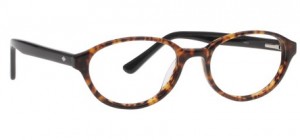High Index Lenses Free You From the Constraints of Glass
Years ago, a strong eyeglass prescription meant being forced to use eye-wear made with thick pieces of literal glass. The thick glass, in turn, necessitated frames made of materials thick enough to hold these lenses. That caused the frames to be clunky and ugly. Worse yet, many frame makers didn’t offer much selection when it came to these types of frames. That left users with basic frames, often in black plastic, that only made everything look even less attractive.
Thankfully, there are now other options for handling strong prescriptions. Some of the best of these are high index lenses. These lenses are ground from lightweight plastic. Plastic can be ground much thinner than glass without losing its ability to bend light, so it will fit into a much wider variety of frames. This allows users to ditch the “Coke bottle” look altogether.
Lighter Glasses Are More Comfortable
This is the main reason people who need vision correction for most of their waking hours like their eyeglasses to be light in weight. After a day of wear, the bridge of the nose and the tops of the ears shouldn’t feel like they’ve been holding up bricks. Heavy, old-fashioned glasses sometimes even cut grooves in wearers’ noses! This isn’t a problem with high-index lenses and properly-fitted frames.
Comfort is important even if the glasses are only used for certain activities, such as reading. Heavy glasses tend to slip down the nose when the wearer’s head is tilted downward. This makes it a hassle to try to read or do certain projects while wearing the old-fashioned variety. Lightweight, plastic high-index lenses make it much easier to concentrate on your activity – not your glasses.
Thinner Lenses Allow for Better-Looking Frames
Since so many people either have weaker prescriptions or use high-index lenses, frame makers don’t put much effort into coming up with attractive designs for holding thick lenses. The end result is that those who use the thick lenses are stuck with a few unattractive designs. Switching to high-index lenses will allow you access to attractive, mainstream designs that you’ll be happy to wear.
High-Index Lenses Prevent the Bug-Eyed Look
With older, thicker lenses, the wearer often ended up looking either bug-eyed or like he had tiny eyes. This is because the prescription of the lens had an effect when viewed from the outside of the glasses as well as from the wearer’s side. A large magnifying prescription would make the wearer’s eyes look big, while a minimizing prescription would make them look extra-small. Either way, the end result was a wearer who looked quite strange.
High-index lenses don’t product this effect. Therefore, wearers can have the confidence that they won’t look weird while they have their glasses on. This is very important for image-conscious people as well as those who just don’t want to attract odd stares.
Should Everyone Switch to High-Index Lenses?
Not necessarily. Some prescriptions are still better handled by old-fashioned glass lenses or a different form of plastic ones. Also, those with low-power prescriptions won’t need to choose high-index lenses because regular thin ones can bend the light enough on their own. Prospective wearers should also note that high-index lenses might not produce full clarity when objects are viewed from certain angles.
That said, anyone who is currently wearing glasses with thick lenses should ask their eye doctor about the possibility of switching to a high-index version. Chances are that the answer will be yes, and that the switch will provide sufficient clarity for everyday use. Then, making the change is as simple as picking out a beautiful new frame and having the glasses made!



Leave a Reply
You must be logged in to post a comment.